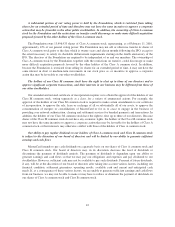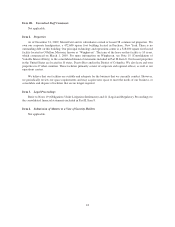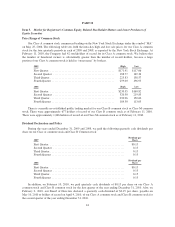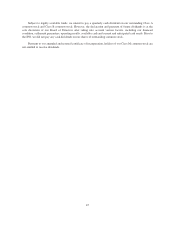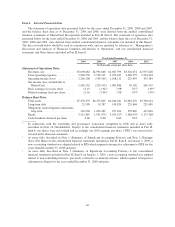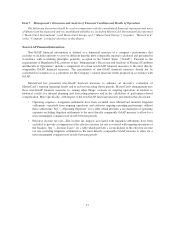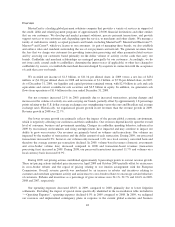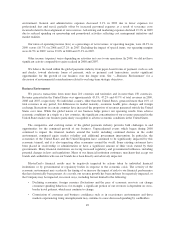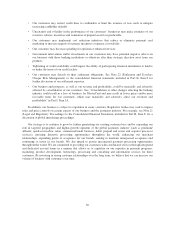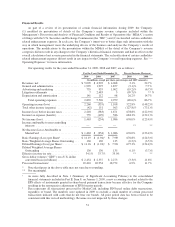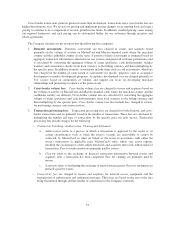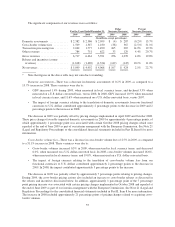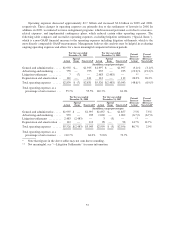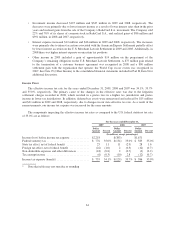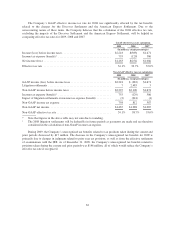MasterCard 2009 Annual Report Download - page 62
Download and view the complete annual report
Please find page 62 of the 2009 MasterCard annual report below. You can navigate through the pages in the report by either clicking on the pages listed below, or by using the keyword search tool below to find specific information within the annual report.Impact of Foreign Currency Rates
Our overall operating results are impacted by changes in foreign currency exchange rates, especially the
strengthening or weakening of the U.S. dollar versus the euro and Brazilian real. The functional currency of
MasterCard Europe, our principal European operating subsidiary, is the euro, and the functional currency of our
Brazilian subsidiary is the Brazilian real. Accordingly, the strengthening or weakening of the U.S. dollar versus
the euro and Brazilian real impacts the translation of our European and Brazilian subsidiaries’ operating results
into the U.S. dollar. For 2009 as compared to 2008, the U.S. dollar average exchange rates strengthened against
the euro and Brazilian real, which resulted in lower revenues and expenses. For 2008 as compared to 2007, the
U.S. dollar weakened against the euro and Brazilian real, which increased revenues and expenses.
In addition, changes in foreign currency exchange rates directly impact the calculation of gross dollar
volume and gross euro volume (“GEV”), which are used in the calculation of our domestic assessments, cross-
border volume fees and volume related rebates and incentives. In most non-European regions, GDV is calculated
based on local currency spending volume converted to U.S. dollars using average exchange rates for the period.
In Europe, GEV is calculated based on local currency spending volume converted to euros using average
exchange rates for the period. As a result, our domestic assessments, cross-border volume fees and volume
related rebates and incentives are impacted by the strengthening or weakening of the U.S. dollar versus most
non-European local currencies and the strengthening or weakening of the euro versus European local currencies.
The strengthening or weakening of the U.S. dollar is evident when GDV on a U.S. dollar converted basis is
compared to GDV on a local currency basis. In 2009 and 2008, GDV on a U.S. dollar converted basis declined
3.3% and increased 11.6%, respectively, versus GDV growth on a local currency basis of 1.4% and 10.9%,
respectively.
Revenues
Revenue Descriptions
MasterCard’s business model involves four participants in addition to us: cardholders, merchants, issuers
(the cardholders’ banks) and acquirers (the merchants’ banks). Our gross revenues are typically based on the
volume of activity on cards that carry our brands, the number of transactions we process for our customers or the
nature of other payment-related services we provide to our customers. Our revenues are based upon transactional
information accumulated by our systems or reported by our customers. Our primary revenue billing currencies
are the U.S. dollar, euro and Brazilian real.
We process transactions denominated in more than 150 currencies through our global system, providing
cardholders with the ability to utilize, and merchants to accept, MasterCard cards across multiple country
borders. We process most of the cross-border transactions using MasterCard, Maestro and Cirrus-branded cards
and process the majority of MasterCard-branded domestic transactions in the United States, United Kingdom,
Canada, Brazil and Australia.
Our pricing is complex and is dependent on the nature of the volumes, types of transactions and other
products and services we offer to our customers. A combination of the following factors determines the pricing:
• Domestic or cross-border
• Signature-based (credit and offline debit) or PIN-based (on-line debit, including automated teller
machine (“ATM”) cash withdrawals and retail purchases)
• Tiered pricing, with rates decreasing as customers meet incremental volume/transaction hurdles
• Geographic region or country
• Retail purchase or cash withdrawal
52


